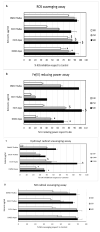Unlocking the Therapeutic Potential of Marine Collagen: A Scientific Exploration for Delaying Skin Aging
- PMID: 38667776
- PMCID: PMC11050892
- DOI: 10.3390/md22040159
Unlocking the Therapeutic Potential of Marine Collagen: A Scientific Exploration for Delaying Skin Aging
Abstract
Aging is closely associated with collagen degradation, impacting the structure and strength of the muscles, joints, bones, and skin. The continuous aging of the skin is a natural process that is influenced by extrinsic factors such as UV exposure, dietary patterns, smoking habits, and cosmetic supplements. Supplements that contain collagen can act as remedies that help restore vitality and youth to the skin, helping combat aging. Notably, collagen supplements enriched with essential amino acids such as proline and glycine, along with marine fish collagen, have become popular for their safety and effectiveness in mitigating the aging process. To compile the relevant literature on the anti-aging applications of marine collagen, a search and analysis of peer-reviewed papers was conducted using PubMed, Cochrane Library, Web of Science, and Embase, covering publications from 1991 to 2024. From in vitro to in vivo experiments, the reviewed studies elucidate the anti-aging benefits of marine collagen, emphasizing its role in combating skin aging by minimizing oxidative stress, photodamage, and the appearance of wrinkles. Various bioactive marine peptides exhibit diverse anti-aging properties, including free radical scavenging, apoptosis inhibition, lifespan extension in various organisms, and protective effects in aging humans. Furthermore, the topical application of hyaluronic acid is discussed as a mechanism to increase collagen production and skin moisture, contributing to the anti-aging effects of collagen supplementation. The integration of bio-tissue engineering in marine collagen applications is also explored, highlighting its proven utility in skin healing and bone regeneration applications. However, limitations to the scope of its application exist. Thus, by delving into these nuanced considerations, this review contributes to a comprehensive understanding of the potential and challenges associated with marine collagen in the realm of anti-aging applications.
Keywords: anti-aging; antioxidant; biopeptide; bone regeneration; extracellular matrix (ECM); fish collagen; marine collagen; prevention; skin.
Conflict of interest statement
The authors declare no conflicts of interest.
Figures








Similar articles
-
Marine Collagen: A Promising Biomaterial for Wound Healing, Skin Anti-Aging, and Bone Regeneration.Mar Drugs. 2022 Jan 10;20(1):61. doi: 10.3390/md20010061. Mar Drugs. 2022. PMID: 35049916 Free PMC article. Review.
-
Phytoextracts as Natural Anti-Aging Agents: Mechanisms and Strategies for Skin Rejuvenation.Curr Aging Sci. 2025 Mar 3. doi: 10.2174/0118746098363055250218040726. Online ahead of print. Curr Aging Sci. 2025. PMID: 40033591
-
Elicited ROS Scavenging Activity, Photoprotective, and Wound-Healing Properties of Collagen-Derived Peptides from the Marine Sponge Chondrosia reniformis.Mar Drugs. 2018 Nov 23;16(12):465. doi: 10.3390/md16120465. Mar Drugs. 2018. PMID: 30477144 Free PMC article.
-
Can good sleep quality enhance the benefits of oral collagen supplementation in the prevention of skin aging? A brief report.Arch Dermatol Res. 2025 Feb 6;317(1):340. doi: 10.1007/s00403-025-03860-5. Arch Dermatol Res. 2025. PMID: 39912934 Review.
-
A Novel Hyaluronic Acid Matrix Ingredient with Regenerative, Anti-Aging and Antioxidant Capacity.Int J Mol Sci. 2023 Mar 1;24(5):4774. doi: 10.3390/ijms24054774. Int J Mol Sci. 2023. PMID: 36902203 Free PMC article.
Cited by
-
Mitochondrial Dysfunction and Its Potential Molecular Interplay in Hypermobile Ehlers-Danlos Syndrome: A Scoping Review Bridging Cellular Energetics and Genetic Pathways.Curr Issues Mol Biol. 2025 Feb 19;47(2):134. doi: 10.3390/cimb47020134. Curr Issues Mol Biol. 2025. PMID: 39996855 Free PMC article. Review.
-
Promoting collagen synthesis: a viable strategy to combat skin ageing.J Enzyme Inhib Med Chem. 2025 Dec;40(1):2488821. doi: 10.1080/14756366.2025.2488821. Epub 2025 Apr 11. J Enzyme Inhib Med Chem. 2025. PMID: 40213810 Free PMC article. Review.
-
Multifaceted Marine Peptides and Their Therapeutic Potential.Mar Drugs. 2025 Jul 15;23(7):288. doi: 10.3390/md23070288. Mar Drugs. 2025. PMID: 40710513 Free PMC article. Review.
-
A Comprehensive Review on the Valorization of Bioactives from Marine Animal By-Products for Health-Promoting, Biofunctional Cosmetics.Mar Drugs. 2025 Jul 26;23(8):299. doi: 10.3390/md23080299. Mar Drugs. 2025. PMID: 40863616 Free PMC article. Review.
-
Recombinant Humanized Collagen Enhances Secreted Protein Levels of Fibroblasts and Facilitates Rats' Skin Basement Membrane Reinforcement.J Funct Biomater. 2025 Feb 1;16(2):47. doi: 10.3390/jfb16020047. J Funct Biomater. 2025. PMID: 39997581 Free PMC article.
References
Publication types
MeSH terms
Substances
LinkOut - more resources
Full Text Sources
Medical

